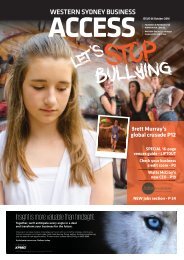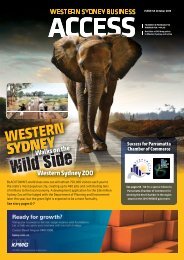ANITA COBBY
WSBA January 2016 Edition
WSBA January 2016 Edition
Create successful ePaper yourself
Turn your PDF publications into a flip-book with our unique Google optimized e-Paper software.
CHILDSCENE<br />
WWW.WSBA.COM.AU<br />
Why teach your kids code?<br />
LITERACY<br />
By Steve Goschnick<br />
Adjunct Professor, Swinburne<br />
University of Technology<br />
AMONG Malcolm Turnbull’s first words<br />
as the newly elected leader of the Liberal<br />
Party, and hence heading for the Prime<br />
Minister’s job, were: “The Australia of<br />
the future has to be a nation that is agile, that<br />
is innovative, that is creative.”<br />
And near the heart of the matter is the<br />
code literacy movement. This is a movement<br />
to introduce all school children to the concepts<br />
of coding computers, starting in primary<br />
school.<br />
One full year after the computing curriculum<br />
was introduced by the UK government, a<br />
survey there found that six out of ten parents<br />
want their kids to learn a computer language<br />
instead of French.<br />
The language of code<br />
The language comparison is interesting<br />
because computer languages are first and<br />
foremost, languages. They are analogous to the<br />
written versions of human languages but simpler,<br />
requiring expressions without ambiguity.<br />
They have a defining grammar. They come<br />
with equivalent dictionaries of nouns, verbs,<br />
adjectives and adverbs; with prepositions and<br />
phrase patterns, conjunctions, conditionals<br />
and clauses. Of course the dictionaries are less<br />
extensive than those of human languages, but<br />
the pattern rendering nature of the grammars<br />
have much the same purpose.<br />
Kids that code gain a good appreciation of<br />
computational thinking and logical thought,<br />
which helps them develop good critical<br />
thinking skills. I’ve sometimes heard the term<br />
“language lawyer” used as a euphemism for a<br />
pedantic programmer. Code literacy is good<br />
for their life skills kit, never mind their career<br />
prospects.<br />
Scratch is one of a new generation of block<br />
programming languages aimed at teaching<br />
novices and kids as young as eight or nine to<br />
write code.<br />
Scratch teaches code with movable instruction<br />
blocks. Screenshot from code.org<br />
The Scratch language uses coloured blocks<br />
to represent the set of language constructs in<br />
its grammar. A novice programmer can build<br />
up a new program by dragging-and-dropping<br />
from a palette of these blocks onto a blank<br />
canvas or workspace.<br />
The individual shapes of the blocks are<br />
puzzle-like, such that only certain pieces can<br />
interlock. This visually enforces the grammar,<br />
allowing the coder to concentrate on the<br />
creativeness of their whole program.<br />
The Scratch language (and its derivatives)<br />
are embedded in a number of different<br />
tools and websites, each dedicated to a<br />
particular niche of novice programmers. The<br />
code.org website is a prime example and has<br />
a series of exercises using the block language<br />
to teach the fundamentals of computer science.<br />
Code.org is a non-profit used by 6 million<br />
students, 43% of whom are female. It runs the<br />
Hour of Code events each year, a global effort<br />
to get novices to try to do at least an hour of<br />
code.<br />
For a week in May this year, Microsoft<br />
Australia partnered with Code.org to run the<br />
#WeSpeakCode event, teaching coding to<br />
more than 7,000 young Australians. My local<br />
primary school in Belgrave South in Victoria is<br />
using Code.org successfully with grade 5 and<br />
6 students.<br />
Unlike prose in a human language, computer<br />
programs are most often interactive. In<br />
the screenshot of the Scratch example (above)<br />
it has graphics from the popular Plants vs<br />
Zombies game, one that most kids have already<br />
played. They get to program some basic<br />
mechanics of what looks a little like the game.<br />
But code.org has a ‘Show Code’ button<br />
that reveals the JavaScript code generated<br />
behind the coloured blocks (see above). This<br />
shows novices what they created in tiles, translated<br />
into the formal syntax of a programming<br />
language widely used in industry.<br />
It’s not all about the ICT industry<br />
Both parents and politicians with an eye<br />
to the future see the best jobs as the creative<br />
ones. Digging up rocks, importing, consuming<br />
and servicing is not all that should be done in<br />
a forward-thinking nation.<br />
But teaching kids to code is not all about<br />
careers in computer programming, science<br />
and software engineering. Introducing young<br />
minds to the process of instructing a computer<br />
allows them to go from “I swiped this”<br />
to “I made this”. From watching YouTube stars,<br />
to showing schoolyard peers how they made<br />
their pet cat photo meow.<br />
It opens up young minds to the creative aspects<br />
of programming. Not only widening the<br />
possible cohort who may well study computer<br />
science or some other information and communications<br />
technology (ICT) professions,<br />
but also in design and the creative arts, and<br />
other fields of endeavour yet to transpire or be<br />
disrupted.<br />
For most kids, teaching them to code is<br />
about opening their mind to a means to an<br />
end, not necessarily the end in itself.<br />
THIS ARTICLE WAS FIRST PUBLISHED AT WWW.THECONVERSATION.COM.AU<br />
40 WESTERN SYDNEY BUSINESS ACCESS JANUARY 2016






